
In Christian belief, a saint is a person who is recognized as having an exceptional degree of holiness, likeness, or closeness to God. However, the use of the term saint depends on the context and denomination. In Catholic, Eastern Orthodox, Anglican, Oriental Orthodox, and Lutheran doctrine, all of their faithful deceased in Heaven are considered to be saints, but some are considered worthy of greater honor or emulation. Official ecclesiastical recognition, and consequently a public cult of veneration, is conferred on some denominational saints through the process of canonization in the Catholic Church or glorification in the Eastern Orthodox Church after their approval.

Veneration, or veneration of saints, is the act of honoring a saint, a person who has been identified as having a high degree of sanctity or holiness. Angels are shown similar veneration in many religions. Veneration of saints is practiced, formally or informally, by adherents of some branches of all major religions, including Christianity, Judaism, Hinduism, Islam, Buddhism and Jainism.

Sergius of Radonezh was a spiritual leader and monastic reformer of medieval Russia. Together with Seraphim of Sarov, he is one of Eastern Orthodoxy's most highly venerated saints in Russia.
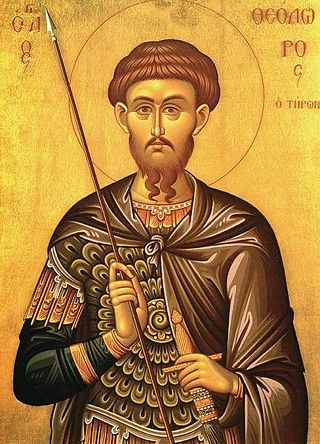
Saint Theodore, distinguished as Theodore of Amasea, Theodore the Recruit, and by other names, is a Christian saint and Great Martyr, particularly revered in the Eastern Orthodox Churches but also honored in Roman Catholicism and Oriental Orthodoxy. According to legend, he was a legionary in the Roman army who suffered martyrdom by immolation at Amasea in Galatian Pontus during the Great Persecution under Diocletian in the early 4th century. Venerated by the late 4th century, he became a prominent warrior saint during the Middle Ages, attracted a great deal of additional legends including accounts of battle against dragons, and was often confused with the similar Theodore Stratelates of Heraclea.
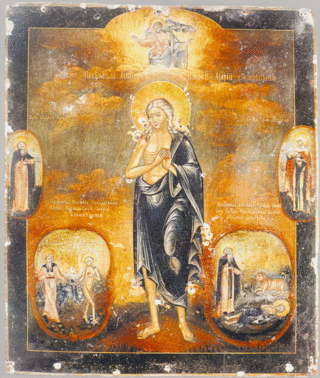
Mary of Egypt was an Egyptian grazer saint dwelling in Palestine during Late antiquity or the Early Middle Ages. She is highly venerated as a Desert Mother in the Eastern Orthodox and Coptic Churches. The Catholic Church commemorates her as a patron saint of penitents.

Göreme is a town (belde) in the Nevşehir District, Nevşehir Province in Central Anatolia, Turkey. Its population is 2,034 (2022). It is well known for its fairy chimneys, eroded rock formations, many of which were hollowed out in the Middle Ages to create Christian churches, houses and underground cities. Göreme was formerly known as Korama, Matiana, Macan and Avcilar.

Sep. 1 - Eastern Orthodox liturgical calendar - Sep. 3

May 26 - Eastern Orthodox Church calendar - May 28
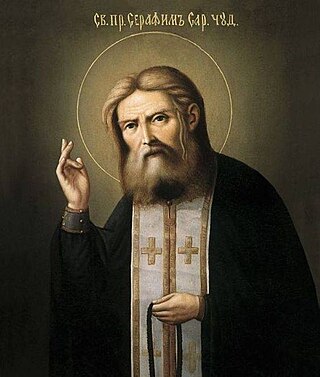
Seraphim of Sarov, born Prókhor Isídorovich Moshnín (Mashnín) [Про́хор Иси́дорович Мошни́н (Машни́н)], is one of the most renowned Russian saints and is venerated in the Eastern Orthodox Church and the Anglican Communion. He is generally considered the greatest of the 18th-century startsy (elders). Seraphim extended the monastic teachings of contemplation, theoria and self-denial to the layperson. He taught that the purpose of the Christian life was to receive the Holy Spirit. Perhaps his most popular quotation amongst his devotees is "Acquire the Spirit of Peace, and thousands around you will be saved."

July 2 - Eastern Orthodox Church calendar - July 4

John of Shanghai and San Francisco was a prominent ascetic and prelate of the Russian Orthodox Church Outside Russia. He was a pastor and reputed wonderworker with purported powers of prophecy, clairvoyance and healing. He is often referred to as St. John the Wonderworker.

Güzelyurt, meaning 'beautiful homeland', formerly Gelveri, is a town in Aksaray Province in the Central Anatolia region of Turkey, at a distance of 45 km (28 mi) from the city of Aksaray. It is the seat of Güzelyurt District. Its population is 2,570 (2021). Its elevation is 1,485 m (4,872 ft).

Ürgüp is a town in Nevşehir province in the Cappadocia area of Central Anatolia, Turkey. It is the seat of Ürgüp District. Its population is 24,647 (2022). The town lies at an average elevation of 1,044 m (3,425 ft).
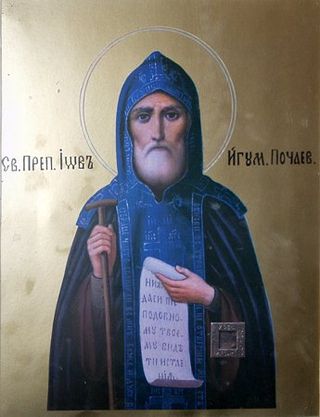
Job of Pochayev, to the world Ivan Zalizo, in Great Schema John was an Eastern Orthodox monk and saint.
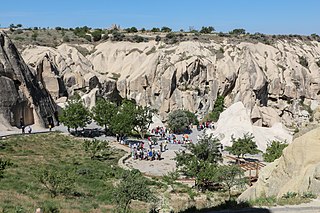
Göreme is a district of the Nevşehir Province in Turkey. After the eruption of Mount Erciyes about 2.6 million years ago, ash and lava formed soft rocks in the Cappadocia region, covering a region of about 20,000 square kilometres (7,700 sq mi). The softer rock was eroded by wind and water, leaving the hard cap rock on top of pillars, forming the present-day fairy chimneys. People of Göreme, at the heart of the Cappadocia region, realized that these soft rocks could be easily carved out to form houses, churches, and monasteries. These Christian sanctuaries contain many examples of Byzantine art from the post-iconoclastic period. These frescos are a unique artistic achievement from this period.

October 13 - Eastern Orthodox liturgical calendar - October 15

November 9 - Eastern Orthodox liturgical calendar - November 11

December 6 - Eastern Orthodox liturgical calendar - December 8

Mustafapaşa, formerly known as Sinasos, is a village in the Ürgüp District of Nevşehir Province, Turkey. Its population is 1,295 (2022). Before the 2013 reorganisation, it was a town (belde). It lies to the west of Gomeda valley and is 5 kilometres (3.1 mi) away from Ürgüp and 27 kilometres (17 mi) away from Nevşehir town.
The Monastery of Saint David the Elder, also known as the Monastery of Saint David of Euboea, is a Greek Orthodox monastery located near the village of Drimona, near the town of Limni, on the Greek island of Euboea.













